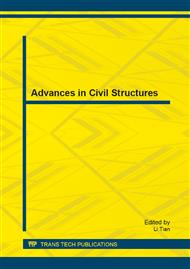p.1289
p.1293
p.1298
p.1302
p.1306
p.1312
p.1318
p.1325
p.1333
Arch Dam Deformation Prediction Model Based on PSO-SVM
Abstract:
Arch dam has gradually evolved as one of dam type as main large-scale hydraulic project, dam deformation prediction is an important part of dam safety monitoring, and it is difficult to forecast because of the complicated nonlinear characteristics of the monitoring data. Support Vector Machine (SVM) could solve the small sample, nonlinear high dimension problem due to the excellent generalization ability, and hence it has been widely used in the forecast of arch dam deformation. However, the forecast results considerably depend on the choice of SVM model parameters. In this paper, Particle Swarm Optimization (PSO), which has the characteristic of fast global optimization, was applied to optimize the parameters in SVM, and then the dam deformation prediction model based on PSO-SVM could be established. The model is applied to a certain arch dam foundation prediction. The accuracy of this employed approach was examined by comparing it with multiple regression method. In a word, the experimental results indicate that the proposed method based on PSO-SVM can be used in arch dam deformation prediction.
Info:
Periodical:
Pages:
1306-1311
Citation:
Online since:
August 2013
Authors:
Price:
Сopyright:
© 2013 Trans Tech Publications Ltd. All Rights Reserved
Share:
Citation:


